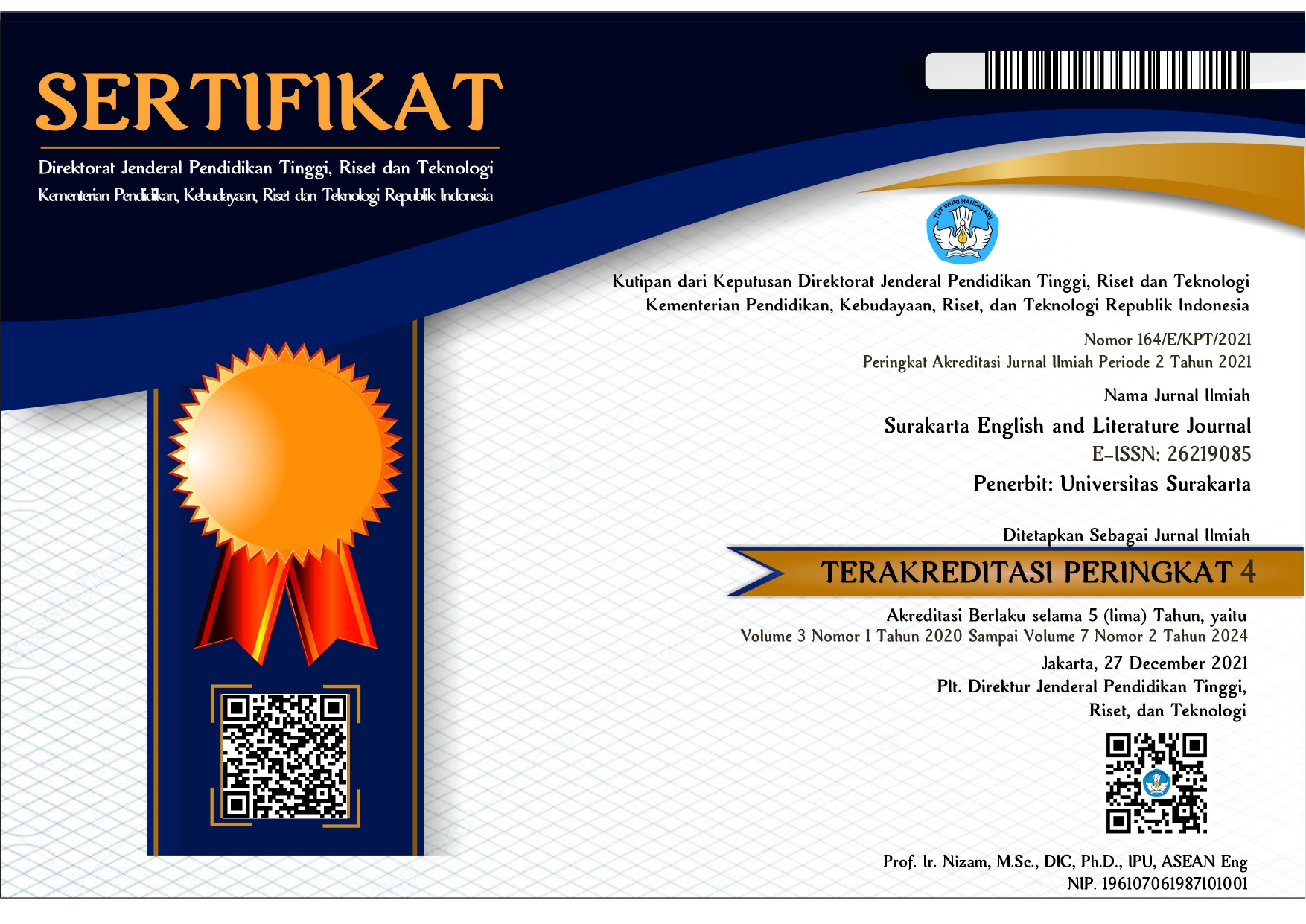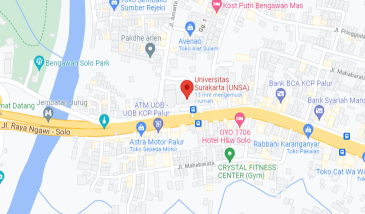Exploring the Effect of the Pace Model on Students’ Grammar Mastery and Students’ Voices on Its Usage
Keywords:
English grammar, PACE model, online classAbstract
Students commonly regard grammar as a challenging element of English. Therefore, every
English teacher is always encouraged to use effective alternatives. Furthermore, the teaching and learning process that is still running online often causes many obstacles. One of the recommended teaching models for grammar class is PACE Model. This study explored the effectiveness of the PACE model to teach English grammar and students’ voices toward this model. The method employed was pre-experimental research or one group pre-test post-test design. For collecting the data, the team employed a test and a questionnaire. The data were analysed using simple statistical calculations like average and percentage. The result revealed that the PACE model is an effective way of teaching English grammar because the average score of the post-test (52.33) was higher than the pre-test (24.67). There was a significant improvement in the test result. The data from the questionnaire also showed that most of the students had positive perceptions about the usage of the PACE Model. Overall, the PACE model was an adequate model to teach English grammar online because it received positive responses from the students
References
A’yun, I. L. Q. (2019). Teaching and Learning English Grammar through Discourse for EFL Students. Journal of Development Research, 3(2), 89–98. https://doi.org/https://doi.org/10.28926/jdr.v3i2.83
Al-mekhlafi, A. M., & Nagaratnam, R. P. N. (2011). Difficulties in Teaching and Learning Grammar in an Efl Context. International Journal of Instruction, 4(2), 69–92.Ameliani, A. N. (2019). Students ’Difficulties in Grammar of Seventh Grade Junior High School 1 Magelang. Conference of English Language and Literature (CELL).
Aniuranti, A. (2021). The Use of Ice Breakers in Online English Grammar. Surakarta English and Literature Journal, 4(2), 85–97.
Aniuranti, A., Faiza, D., & Wulandari, Y. (2021). Enhancing Students ’ Understanding Of English Grammar Through Literary Works And Exploring Students ’ Voice On Their Use. Scholaria: Jurnal Pendidikan Dan Kebudayaan, 11(3), 264–270.
Aniuranti, A., & Rizkina, P. A. (2019). Using ‘Because You Loved Me’ Song To Teach Past Simple in Efl Classrooms. Tarling : Journal of Language Education, 2(2), 135–146. https://doi.org/10.24090/tarling.v2i2.2932
Arikunto, S. (2009). Prosedur penelitian suatu pendekatan praktik. In Jakarta: Rineka Cipta. http://r2kn.litbang.kemkes.go.id:8080/handle/123456789/62880
Ary, D., Jacobs, L. C., Sorensen, C., & Razavieh, A. (2010). Introduction to Research in Education(Vol. 148). Wadsworth, Cengage Learning.
Azar, B. S. (2000). Understanding and Using English Grammar. Pearson Education.
Effendi, M. S., Rokhyati, U., Rachman, U. A., Rakhmawati, A. D., & Pertiwi, D. (2017). A Study on Grammar Teaching at an English Education Department in an EFL Context. International Journal on Studies in English Language and Literature, 5(1), 42–46. https://doi.org/10.20431/2347-3134.0501005
Efriana, L. (2021). Problems of Online Learning during Covid-19 Pandemic in EFL Classroom and the Solution. JELITA:Journal of English Language Teaching and Literature, 2(1), 38–47.
González-Bueno, M. (2021). Applied Language Learning. In J. Howard (Ed.), Applied Language Learning (Vols. 29–39). Defense Language Institute Foreign Language Center. http://www.dliflc.edu/resources/publications/applied-language-learning/
Groeneveld, A. (2011). Adjective or Adverb ? Teaching Grammar with the PACE Model. Levende Talen Tijdschrift, 12(3), 24–33.
Handayani, N., & Johan, M. (2018). Problem Faced in Grammar of EFL Students. Ilmu Khazanah Berazam, 1(2), 33–41.
Harmer, J. (2003). The Practice of English Language Teaching. Longman. https://doi.org/10.1093/elt/57.4.40
Martin Hewings. (2002). Advanced Grammar in Use. Cambride University Press
Murphy, R. (2004). English Grammar in Use. Cambride University Press
Nartiningrum, N., & Nugroho, A. (2021). English teachers’ perspectives on challenges, suggestions, and materials of online teaching amidst the global pandemic. IJEE (Indonesian Journal of English Education), 8(1), 101–119. https://doi.org/10.15408/ijee.v8i1.17886
Nawira, Anugrawati, N., & Muhsin, M. A. (2019). Analyzing Challenges in Grammatical Knowledge for EFL Students: Descriptive Quantitative Study. Jurnal Pendidikan Bahasa Inggris, 8(2), 158–167.
Pyle, M. A., & Page, M. E. M. (2002). TOEFL Preparation Guide: Test of English as a Foreign Language. Wiley Dreamtech India Ltd.
Suwartono. (2014). Dasar-Dasar Metodologi Penelitian. Penerbit ANDI.
Utomo, D. T. P., & Ahsanah, F. (2020). Utilizing Digital Comics in College Students’ Grammar Class. Journal of English Language Teaching and Linguistics, 5(3), 393. https://doi.org/10.21462/jeltl.v5i3.449
Wang, S. (2010). The Significance of English Grammar to Middle School Students in China. Journal of Language Teaching and Research, 1(3), 313–319. https://doi.org/10.4304/jltr.1.3.313-319
Yuliyanto, Y., & Fitriyati, N. R. (2019). Boosting students ’ interest in learning grammar by using quizlet. 111–121.
Yunita, W. (2016). Best Practice in Teaching English Grammar to University Students : Deductive , Inductive , or Combination of Both ? Proceedings of the Fourth International Seminar on English Language and Teaching (ISELT-4), 435–443.
Yunita, W., Mayuni, I., & Emzir. (2018). Integrated Story-Based Grammar Learning Model: The Effectiveness and Students’ Perception on Its Implementation in a Grammar Classroom. Advances in Social Science, Education and Humanities Research, 178, 296–303. https://doi.org/10.2991/icoie-18.2019.66
Downloads
Published
How to Cite
Issue
Section
License
Copyright (c) 2022 Asfi Aniuranti, M.Happy Nur Tsani, Yasinta Wulandari

This work is licensed under a Creative Commons Attribution-ShareAlike 4.0 International License.
Licensing for Data Publication
-
Open Data Commons Attribution License, http://www.opendatacommons.org/licenses/by/1.0/ (default)
-
Creative Commons CC-Zero Waiver, http://creativecommons.org/publicdomain/zero/1.0/
-
Open Data Commons Public Domain Dedication and Licence, http://www.opendatacommons.org/licenses/pddl/1-0/














